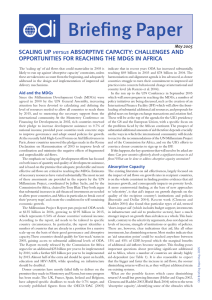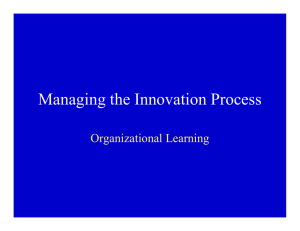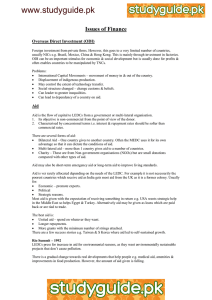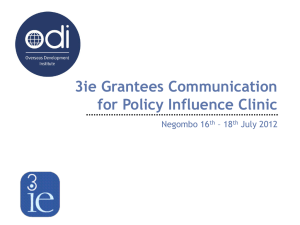Briefing Paper SCALING UP OPPORTUNITIES FOR REACHING THE MDGS IN AFRICA May 2005
advertisement
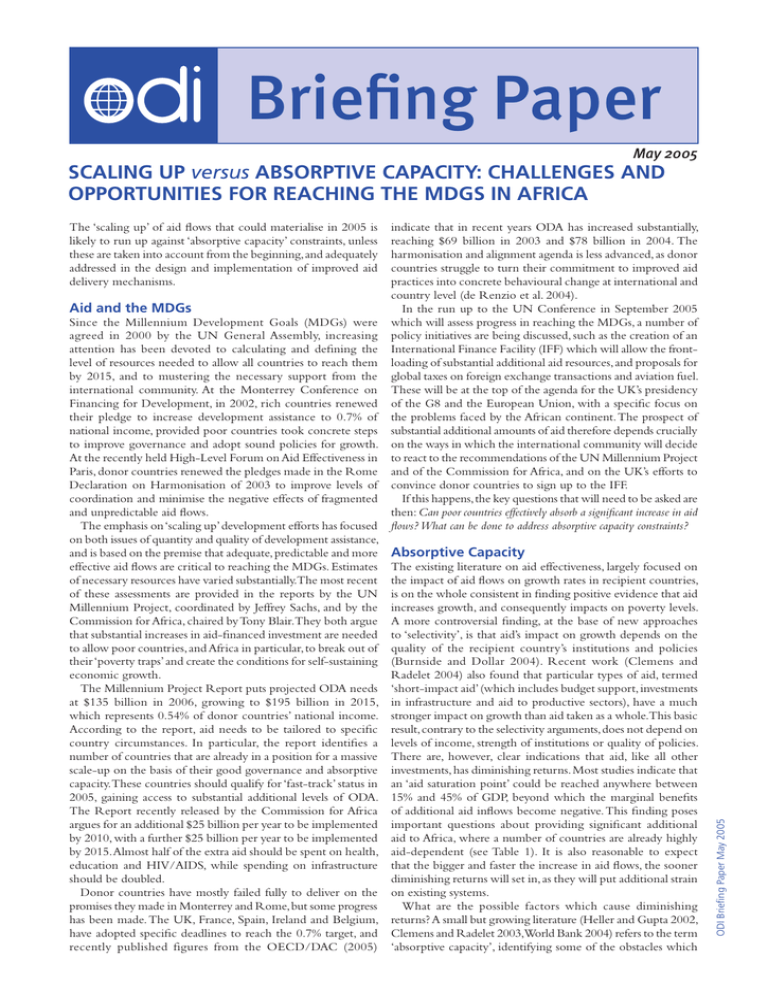
Briefing Paper May 2005 SCALING UP versus ABSORPTIVE CAPACITY: CHALLENGES AND OPPORTUNITIES FOR REACHING THE MDGS IN AFRICA indicate that in recent years ODA has increased substantially, reaching $69 billion in 2003 and $78 billion in 2004. The harmonisation and alignment agenda is less advanced, as donor countries struggle to turn their commitment to improved aid practices into concrete behavioural change at international and country level (de Renzio et al. 2004). Aid and the MDGs In the run up to the UN Conference in September 2005 Since the Millennium Development Goals (MDGs) were which will assess progress in reaching the MDGs, a number of agreed in 2000 by the UN General Assembly, increasing policy initiatives are being discussed, such as the creation of an attention has been devoted to calculating and defining the International Finance Facility (IFF) which will allow the frontlevel of resources needed to allow all countries to reach them loading of substantial additional aid resources, and proposals for by 2015, and to mustering the necessary support from the global taxes on foreign exchange transactions and aviation fuel. international community. At the Monterrey Conference on These will be at the top of the agenda for the UK’s presidency Financing for Development, in 2002, rich countries renewed of the G8 and the European Union, with a specific focus on their pledge to increase development assistance to 0.7% of the problems faced by the African continent. The prospect of national income, provided poor countries took concrete steps substantial additional amounts of aid therefore depends crucially to improve governance and adopt sound policies for growth. on the ways in which the international community will decide At the recently held High-Level Forum on Aid Effectiveness in to react to the recommendations of the UN Millennium Project Paris, donor countries renewed the pledges made in the Rome and of the Commission for Africa, and on the UK’s efforts to Declaration on Harmonisation of 2003 to improve levels of convince donor countries to sign up to the IFF. coordination and minimise the negative effects of fragmented If this happens, the key questions that will need to be asked are and unpredictable aid flows. then: Can poor countries effectively absorb a significant increase in aid The emphasis on ‘scaling up’ development efforts has focused flows? What can be done to address absorptive capacity constraints? on both issues of quantity and quality of development assistance, and is based on the premise that adequate, predictable and more Absorptive Capacity effective aid flows are critical to reaching the MDGs. Estimates The existing literature on aid effectiveness, largely focused on of necessary resources have varied substantially.The most recent the impact of aid flows on growth rates in recipient countries, of these assessments are provided in the reports by the UN is on the whole consistent in finding positive evidence that aid Millennium Project, coordinated by Jeffrey Sachs, and by the increases growth, and consequently impacts on poverty levels. Commission for Africa, chaired by Tony Blair.They both argue A more controversial finding, at the base of new approaches that substantial increases in aid-financed investment are needed to ‘selectivity’, is that aid’s impact on growth depends on the to allow poor countries, and Africa in particular, to break out of quality of the recipient country’s institutions and policies their ‘poverty traps’ and create the conditions for self-sustaining (Burnside and Dollar 2004). Recent work (Clemens and Radelet 2004) also found that particular types of aid, termed economic growth. The Millennium Project Report puts projected ODA needs ‘short-impact aid’ (which includes budget support, investments at $135 billion in 2006, growing to $195 billion in 2015, in infrastructure and aid to productive sectors), have a much which represents 0.54% of donor countries’ national income. stronger impact on growth than aid taken as a whole.This basic According to the report, aid needs to be tailored to specific result, contrary to the selectivity arguments, does not depend on country circumstances. In particular, the report identifies a levels of income, strength of institutions or quality of policies. number of countries that are already in a position for a massive There are, however, clear indications that aid, like all other scale-up on the basis of their good governance and absorptive investments, has diminishing returns. Most studies indicate that capacity. These countries should qualify for ‘fast-track’ status in an ‘aid saturation point’ could be reached anywhere between 2005, gaining access to substantial additional levels of ODA. 15% and 45% of GDP, beyond which the marginal benefits The Report recently released by the Commission for Africa of additional aid inflows become negative. This finding poses argues for an additional $25 billion per year to be implemented important questions about providing significant additional by 2010, with a further $25 billion per year to be implemented aid to Africa, where a number of countries are already highly by 2015. Almost half of the extra aid should be spent on health, aid-dependent (see Table 1). It is also reasonable to expect education and HIV/AIDS, while spending on infrastructure that the bigger and faster the increase in aid flows, the sooner diminishing returns will set in, as they will put additional strain should be doubled. Donor countries have mostly failed fully to deliver on the on existing systems. What are the possible factors which cause diminishing promises they made in Monterrey and Rome, but some progress has been made. The UK, France, Spain, Ireland and Belgium, returns? A small but growing literature (Heller and Gupta 2002, have adopted specific deadlines to reach the 0.7% target, and Clemens and Radelet 2003,World Bank 2004) refers to the term recently published figures from the OECD/DAC (2005) ‘absorptive capacity’, identifying some of the obstacles which ODI Briefing Paper May 2005 The ‘scaling up’ of aid flows that could materialise in 2005 is likely to run up against ‘absorptive capacity’ constraints, unless these are taken into account from the beginning, and adequately addressed in the design and implementation of improved aid delivery mechanisms. Table 1. Aid Dependence in Africa: Country Examples Population GNI p/c Aid/ GNI Aid p/c Mil. US$ % US$ DR Congo 51.9 100 15 16 Ethiopia 67.2 100 22 19 Malawi 10.7 160 20 35 Mali 11.4 240 15 42 Rwanda 8.2 230 21 44 Sierra Leone 5.2 140 47 67 Tanzania 35.2 290 13 35 SubSaharan Africa 688.9 450 6 28 finding it difficult to recruit, train and retain qualified doctors, nurses, teachers, managers and administrators. In Africa, this is compounded by the effects of the HIV/AIDS pandemic. Moreover, lack of adequate infrastructure and equipment prevents access to goods and services and a more efficient transformation of public spending into improvements in the standard of living. Large increases in aid can address some of these constraints, but potential falls in the productivity of public expenditure should not be overlooked, as unit costs of inputs and staff may rise, technical efficiency may fall and intended beneficiaries may be difficult to reach. Finally, a significant boost in the availability of public services (such as through the elimination of user fees) could be faced by a lack of sufficient demand by service users, as socio-cultural factors may still prevent families from sending their children to school or attending local clinics (see Box 1). Constraints Generated by Donor Behaviour The way the aid system is organised, and the behaviour of donor agencies more in general, can also be a source of absorptive capacity constraints. Fragmented interventions are the rule, with recipient countries having to deal with a plethora of donor organisations, each imposing uncoordinated and burdensome practices through small, dispersed projects. Such fragmentation imposes heavy transaction costs on scarce government capacity, taking time and resources away from core government tasks. Recent shifts towards programme modalities such as sector and general budget support have started to address these concerns, albeit so far with unclear impact. Finally, the lack of certainty and predictability of aid flows can seriously hamper a government’s efforts at medium- and long-term planning, making sure resources are available for development programmes and public investments. Source: World Development Indicators (2002 data) may be limiting aid effectiveness, causing declining marginal returns and, ultimately, limiting the potential role of increased aid flows in reaching the MDGs. Despite the general lack of clarity about the meaning of the term, a possible typology of absorptive capacity constraints would certainly include the following categories: Macroeconomic Constraints Large and sudden increases in aid inflows in the form of foreign currency could provoke a ‘Dutch disease’ effect, causing an appreciation of the exchange rate and therefore harming the export sector. When aid flows are in the form of loans, they can raise concerns about debt sustainability. Aid flows are often unpredictable and volatile, and can therefore negatively influence macroeconomic stability, by triggering inflation, interest-rate and exchange-rate volatility. This is often more the case when aid is in the form of budget support, which is often the first to be reduced for political reasons, and can cause serious fiscal imbalances. Finally, aid increases can cause labour market pressures, by increasing demand for skilled labour and driving up wages. Box 1. Constraints to Scaling-Up in the Health Sector The Commission for Macroeconomics and Health, established in 2002, focused on the analysis of the factors hampering the widespread implementation of a set of interventions which could significantly improve the health of poor people in a relatively short time. They found that as well as an absolute lack of resources, access to health interventions is hindered by a number of problems at different levels: • At community and household level, lack of demand and physical, financial and social barriers to access; • At health service delivery level, shortage of qualified staff, weak management, and lack of adequate infrastructure and supplies, including accessibility; • At health sector policy level, weak systems and regulations, weak incentives to use inputs efficiently, lack of inter-sectoral partnerships, aid dependency and donor practices; • At the overall public policy level, overly bureaucratic and centralised systems, and lack of communication and transport infrastructure; • At the environmental level, governance issues such as corruption, political instability and lack of accountability, and issues related to climate and geography. ODI Briefing Paper May 2005 Institutional and Policy Constraints Recent research has highlighted and confirmed the view that ‘institutions matter’ for development. In low income countries, more capacity is needed to generate credible strategies, policies and programmes to transform higher aid levels into positive development outcomes. The transparency and efficiency of budget systems, patterns of public expenditure, the degree of decentralisation of resources and responsibilities, mechanisms to define policy priorities and accountability systems to hold governments responsible are but a few examples of institutional and policy factors that can determine a country’s performance in generating positive development outcomes. In many countries, such systems may not be adequate to absorb large increases in available resources without increasing wastage or fuelling leakage and corruption (see Box 1). High (and increasing) levels of aid dependency can also provide negative incentives for much needed reforms, and shift government accountability from domestic to international actors. Some of these constraints are more amenable to improvements through additional funds than others. For example, while shortages of inputs (e.g. staff, drugs and supplies, infrastructure and equipment) can be addressed with additional expenditure, other constraints linked to the overall governance and policy framework, and those imposed by geography and climate, cannot easily be solved. Technical and Managerial Constraints Related to the point above, there is a series of more concrete capacity constraints that need to be addressed urgently. Human capital is key in this respect. Many poor countries are Source: Hanson et al. (2003) 2 Absorptive capacity constraints can thus take a variety of different forms. Some of them are likely to be more binding than others, both in the short- and in the long-term.The table below attempts a preliminary classification. Long-term Constraints • ‘Dutch disease’ effects • Aid volatility • Inadequate Public Expenditure Management systems • Perverse incentives in public officials’ performance • Lack of adequate infrastructure and equipment • Post-conflict and postemergency constraints • Uncoordinated donor interventions • Debt sustainability • Major deficiencies in institutions and policy processes • Levels of aid-dependency • Technical and managerial skills of public officials (doctors, teachers, accountants) • Social/Cultural factors determining demand for services • Difficulties in full donor shift to improved practices Botswana has one of the highest reported HIV-prevalence rates in the world. In 2000, the Government established a partnership with the Bill & Melinda Gates Foundation and the pharmaceutical company Merck, Sharp & Dohme to make antiretroviral treatment available in the public sector. A feasibility study was carried out to respond to three key questions: • What is the estimated number of patients who would require ARV therapy? • How well is the country situated to be able to provide ARV therapy from a human, financial and physical resource perspective? • What is the recommended way to tackle the issues and logistics associated with providing effective ARV therapy nationwide? The assessment adopted a demand-supply model which combined clinical research, public health and business principles, and accurately identified the additional resources needed for a successful roll-out (see table 2). The assessment highlighted the lack of pharmacists, lab technicians, viral load tests and storage capacity, and the need to train and involve community health workers in the programme. Subsequently, a detailed launch strategy was developed, focusing first on specific patient groups with the highest need (e.g. HIVinfected women, children and TB patients), and grouping activities by work stream, such as recruitment and training, lab capacity, counselling and community mobilisation, drug distribution, etc. Specific cost estimates were also produced, along with a monitoring system that allowed for the gradual implementation determined by operational readiness of new sites, verified through a minimum requirement check list. The UN Millennium Project and the Commission for Africa tend to underplay the importance of absorptive capacity constraints. The first simply states that ‘scaling up needs to be carefully planned and overseen to ensure successful and sustainable implementation’ (2005:31). The second argues that they do not constitute a stringent obstacle to delivering development benefits, provided that there are (a) continuing policy and governance improvements within Africa, (b) better allocation of aid resources, and (c) better quality assistance. Source: WHO (2004) The Agenda for Action The constraints described above pose serious questions for the proponents of substantial increases in aid levels. What possible approaches can then contribute to create the conditions for the more effective use of additional aid resources? And what can donors do to address these issues in a productive way? The ideas presented below are an initial attempt at identifying the most important areas that need to be addressed. one sector or country, and more generally providing a bigger share of aid through multilateral agencies. Defining the way in which the IFF will function will be important in this respect. Broader reforms of the global aid architecture should also be considered. Careful Design of Interventions Do Your Homework Development interventions should be designed taking absorptive capacity constraints into account, rather than assuming that more resources will immediately translate into improved outcomes. Measures to overcome short-term and long-term constraints should be built into the design phase. Country by country and sector by sector, recipient governments should be assisted in developing sound strategies for scaling up. Innovative approaches which harness the capacities of the private and voluntary sectors can contribute to such efforts (see Box 2 ). Much of the existing evidence on absorptive capacity constraints is scanty and non-conclusive. In particular, both donors and partner governments should invest more resources in understanding the specific dynamics which allow for the effective transformation of public resources into development outcomes. In particular, donors need to understand the political systems of the countries they are working with, and support accountable domestic institutions. This could help in tackling problems related to corruption, élite capture and unrepresentative government. Donors should also strive to adopt a more flexible approach which fits local circumstances, and improve their awareness of the possible perverse effects of aid modalities and donor behaviour. Macroeconomic Management The macroeconomic side of scaling up is often overlooked, with potential conflict between strategies to achieve the MDGs and fiscal constraints imposed by the International Monetary Fund. The limited evidence available shows that sensible macroeconomic management can deal with increased aid inflows, but this will crucially depend on the nature, scale and speed of such increases. One possibility to avoid ‘Dutch disease’ effects is to spend aid resources to import commodities in kind, such as drugs to treat malaria or HIV/AIDS. Otherwise, careful investments to bring down production costs, such as in transport infrastructure, could offset the loss of competitiveness resulting from exchange rate appreciation. Harmonisation and Alignment One of the most important things donors can do is to address more forcefully issues related to fragmentation, high transaction costs and unpredictability. Ensuring that the aid system actually facilitates development processes, rather then hinders them, will depend crucially on radical changes in simplifying procedures, eliminating burdensome practices, relying more on country systems, reducing the overall number of donors acting in any 3 ODI Briefing Paper May 2005 Short-term Constraints Box 2. Introducing ARV Therapy in Botswana Table 2. Additional Needs for ARV Treatment in Botswana Key Resource National capacity Incremental ARV capacity required National capacity increase for ARVs Doctors 514 FTEs 150 FTEs 29% Nurses 4416 FTEs 330 FTEs 8% Pharmacists 29 FTEs 50 FTEs 179% Lab technicians 164 FTEs 90 FTEs 115% Community Health Workers - 1000 FTEs - ELISA tests 1464 per day 700 per day 48% CD4 tests 100 per day 2500 per day 2500% Storage 10 m3 42 m3 420% FTE – Full Time Equivalent. Source: WHO (2004) Renewed Focus on Infrastructure Infrastructure, and the productive sectors in general, has largely been overlooked in recent years, in so far as the distribution of aid resources is concerned. Both the UN Millennium Project and the Africa Commission report put much emphasis on reversing this trend, especially in Africa, where the foreseen increased role of the private sector did not materialise. A substantial boost to aid-financed investment in infrastructure could constitute an important way to contribute to increased sustainability of long-term development efforts.The role of the private sector in both construction and maintenance, and the corresponding capacities of government for outsourcing and managing contractors effectively will be key in this respect. Innovative Delivery Mechanisms Scaling up efforts to assist poor countries in reaching the MDGs should also spur some thinking into alternative arrangements which could either provide better incentives for recipient governments to use resources effectively, or test new delivery mechanisms to reach poor people directly. For example, trust funds could be set up with additional resources for countries to draw down from as they gradually relax absorptive capacity constraints, or as they manage to improve their overall governance systems. Also, a system of direct transfers to poor people could be devised in order to set up something similar to a ‘global welfare system’ (see Box 3). The Agenda for Research ODI Briefing Paper May 2005 While the suggestions presented above provide some initial food for thought in terms of taking absorptive capacity constraints into account, there is a more general need to shed additional light on some of the more controversial issues. Some specific areas for research could help create a better understanding of the conditions in which ‘scaling up’ is a feasible and more effective strategy. Macroeconomic Impact More and better evidence is needed on the impact of increasing aid flows on macroeconomic variables, on the structure of prices and economic output, and on monetary and fiscal management, in order to avoid possible counter-productive effects and to guide changes in the advice that institutions such as the IMF give to poor countries. This will help set a macroeconomic stance that is more conducive to growth and development. Box 3. Cash Transfers as an Alternative Aid Delivery Mechanism There is growing evidence of the effectiveness of direct cash transfers in reducing poverty. Evaluation results from the first generation of Conditional Cash Transfer programmes in Brasil, Mexico and Nicaragua showed clear evidence that they contributed to increasing enrolment rates, improving preventive health care and raising household consumption. Evidence from cash transfers to demobilised soldiers and flood victims in Mozambique also pointed to their low administration costs and contribution to improving livelihoods of recipients. While in rich countries more than 80% of the population is covered by one or more forms of cash transfer programme, in Africa and Asia such programmes only cover less than 10% of the population. This is due to a widespread belief in development policy circles that income transfers to the poor do not work. Such belief needs to be revisited, with more focus given to issues of design and implementation of potential effective interventions. Preconditions for success in cash transfers include transparent targeting criteria, automatic and robust delivery mechanisms and transparency about people’s entitlements. Source: Hanlon (2004), Harvey et al. (2005), Rawlings and Rubio (2003) Politics and Institutions A deeper understanding of the political economy factors driving countries’ development strategy choices, including the incentives created by domestic politics and by the aid relationship, could help shed light on the shortcomings of current donor interventions, and identify better entry points for the assistance and nurturing of development-oriented states. Adopting a more realistic view of some of the political constraints that shape the aid relationship, both on the side of donors and of partner governments, could also help avoid potential problems and failures. Look at Good Examples In order to guide other experiences, research should be carried out which focuses on looking at past success stories, where large increases in external inflows were successfully integrated and utilised for development purposes. Examples of particularly effective sectoral strategies, of the use of natural resource rents, and of reform efforts that allowed for a significant step-change in public sector performance could be drawn upon. For bibilography, see: next page For further information contact the principal author: Paolo de Renzio (p.derenzio@odi.org.uk). © Overseas Development Institute 2005 ISSN 0140-8682 This and other ODI Briefing Papers are on ODI’s website at: www.odi.org.uk Briefing Papers present objective information on important development issues. Readers are encouraged to quote or reproduce material from them for their own publications, but as copyright holder, ODI requests due acknowledgement and a copy of the publication. Overseas Development Institute, 111 Westminster Bridge Road, London SE1 7JD Telephone: +44 (0)20 7922 0300 Fax: +44 (0)20 7922 0399 Email: publications@odi.org.uk Bibliography ODI Briefing Paper May 2005 Burnside, C and Dollar, D. (2004):Aid, Policies and Growth: Revisiting the Evidence. Policy research Working Paper 3251. World Bank, Washington DC. Clemens, M. and Radelet, S. (2003): The Millennium Challenge Account: How much is too much, how long is long enough? Working Paper No.23. Centre for Global Development,Washington DC. Clemens, M., Radelet, S. and Bhavnani, R. (2004): Counting Chickens When They Hatch: The Short-term Effect of Aid on Growth. Working Paper No.44. Centre for Global Development, Washington DC. Commission for Africa (2005): Our Common Interest: Report of the Commission for Africa. Commission for Africa, London. De Renzio, P. with David Booth, Andrew Rogerson and Zaza Curran (2004): Incentives for Harmonisation and Alignment in Aid Agencies. ODI, London. Foster, M. (2003): The Case for Increased Aid. Report to DFID. Hanlon, J. (2004): It is Possible to Just Give Money to the Poor, Development and Change, 35(2), 375-383. Hanson, K., Kent Ranson, M., Oliveira-Cruz,V. and Mills, A. (2003): Expanding Access to Priority Health Interventions : A Framework for Understanding the Constraints to Scaling-Up. Journal of International Development, 15, 1-14. Harvey, P., Slater, R. and Farrington, J. (2005): Cash Transfers: Mere ‘Gadaffi Syndrome’, or Serious Potential for Rural Rehabilitation and Development? Natural Resource Perspectives, Number 97. ODI, London. Heller, P. and Gupta, S. (2002): Challenges in Expanding Development Assistance. IMF Policy Discussion Paper PDP/02/5. IMF, Washington DC. McGillivray, M. (2005): Is Aid Effective? mimeo. UNU/WIDER, Helsinki. OECD/DAC (2005): Development Cooperation report 2004. OECD, Paris. Rawlings, L. and Rubio, G. (2003): Evaluating the Impact of Conditional Cash Transfer Programs: Lessons from Latin America. Policy Research Working Paper 3119. World Bank, Washington DC. UN Millennium Project (2005): Investing in Development: A Practical Plan to Achieve the Millennium Development Goals. UNDP, New York. World Bank (2003): Supporting Sound Policies with Adequate and Appropriate Financing. Paper prepared for the September 2003 meeting of the Development Committee of the World Bank and the IMF. World Bank (2004): Aid Effectiveness and Financing Modalities. Paper prepared for the October 2004 meeting of the Development Committee of the World Bank and the IMF. World Health Organisation (2004): Introducing ARV Therapy in the Public Sector in Botswana: Case Study. Perspectives and Practice in Antiretroviral Treatment. WHO, Geneva. Overseas Development Institute, 111 Westminster Bridge Road, London SE1 7JD Telephone: +44 (0)20 7922 0300 Fax: +44 (0)20 7922 0399 Email: publications@odi.org.uk
